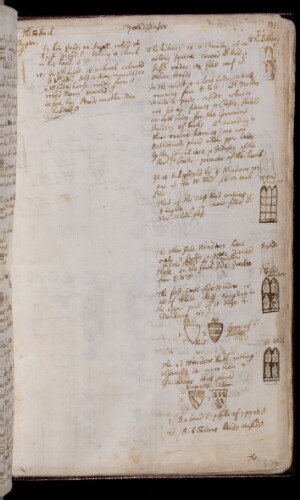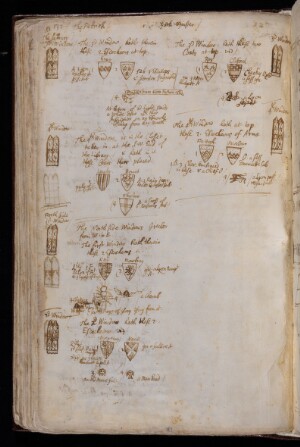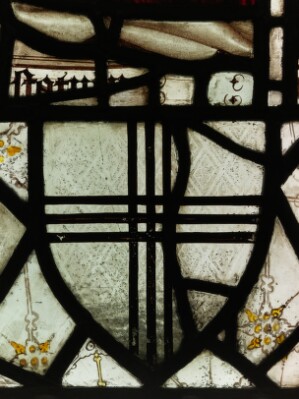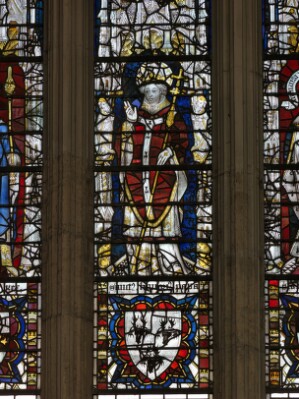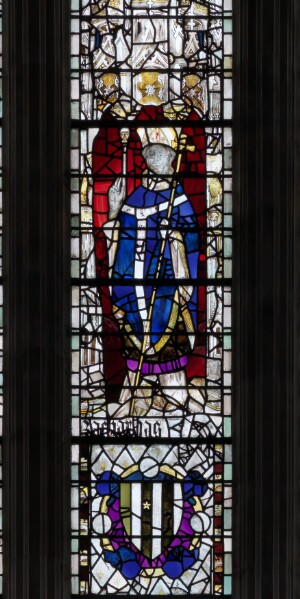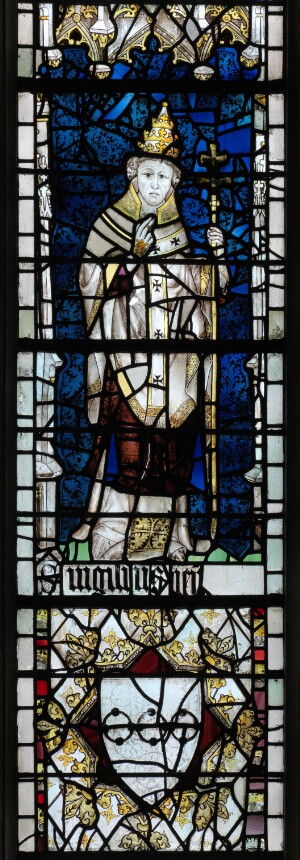The Medieval Glazing of the Minster Library
Sarah Brown (University of York)
Introduction: Date and History
When antiquary James Torre described the interior of the library c.1690, at a time when the collections housed therein were still carefully managed by Precentor Dr Comber, eight of the nine windows in the upper chamber still contained medieval stained glass (1). Only the three-light west window was empty of imagery - filled 'w[i]th new White glass'. Torre's description makes it clear that in common with the slightly later glazing of the medieval libraries of Balliol College, Oxford and Wells Cathedral, the medieval glazing was predominantly heraldic in character, with sixteen shields of arms preserved in the eight windows in the north and south walls, together with a Biblical text (in sIV) and a Corpus Christi image (in nV), as well as other fragmentary remains (Figs. 1 and 2). By the time Francis Drake visited the library in the 1730s, the glass had disappeared (2).
The exact date and the identity of the donor(s) of the library's medieval glazing cannot be established with certainty. Some time between September and November 1418 John Neuton's executor Thomas Haxey, prebendary of Barnby from 1405 to 1418 and Minster treasurer from December 1418 until his death in 1425, is recorded in a Minster fabric roll as having paid for the lead to cover the roof (3). Another insecurely dated fabric roll records the costs of joinery for the library (4). The firmly dated roll of 1422 records those expenses related to the labelling (with horn) and the chaining of Neuton's books, suggesting that by this date the lecterns were in place and the building was ready for use, if not already fully functioning (5). There is no expenditure recorded in connection with the library thereafter and no mention at all that is specific to the library glazing. Despite the provision of shutters, it seems unlikely that the library, on which no expense was spared, was left unglazed for very long. The stained glass can probably therefore be dated to the period 1418-22.
Torre's description
Torre recorded the following shields and subjects, described here from east to west, using the Corpus Vitrearum notation. Those shields of undisputed identity are not tricked:
| South Wall | North Wall | ||
| sII | 2a Blank shield | nII | 2a Arms of Fitzhugh |
| 2b 'Barry of six sa[ble] & o[r]'. Unidentified (6) | 2b Arms of Vavasour | ||
| 1a Diamond quarries | 1a Diamond quarries | ||
| 1a Diamond quarries | 1b 'a lyon pass[ant] regard[ant]' | ||
| sIII | 2a Arms of Scrope of Masham | nIII | 2a Arms of Ros |
| 2b 'B[lue] 6 Falcons heads erased o[r]. Fenton' (Probably the arms of John Neuton) | 2b Arms of Clifford | ||
| 1a Diamond quarries | 1a Diamond quarries | ||
| 1b Diamond quarries | 1b 'a lyon sejant' | ||
| sIV | 2a Arms of Thomas Haxey | nIV | 2a Arms of Percy modern |
| 2b 'Sab[le] 3 Escallops & a border ingrailed A[rgent]' | 2b Arms of Neville | ||
| 1a Diamond quarries | 1a 'an old man's face' | ||
| 1b Dove with scroll, 'Verbum caro factum est' | 1b 'a man's head' | ||
| sV | 2a Arms of Langley | nV | 2a Arms of England |
| 2b Arms of Archbishop Henry Bowet | 2b Arms of Mowbray | ||
| 1a Diamond quarries | 1a Corpus Christi symbol | ||
| 1b Arms of Bishop Walter Skirlaw | 1b 'Cherub' | ||
| West Window: Filled with 'new white glass' | |||
The Windows
While in common with many secular cathedrals, York Minster lagged behind the University colleges in providing a separate, purpose-built library, in one important regard the Minster library is at the forefront of medieval library design, in step with the trend exemplified at New College (in use in the 1390s), in that it has numerous and generously proportioned windows relative to its size. Each of the four windows in the north and south walls of the York library room, located as was by now common practice on the first floor, is of two lights, sub-divided by a transom to create four compartments. The west window is of three lights without sub-division. The location of the library was presumably carefully chosen to ensure that the long walls could be advantageously oriented east-west, a common feature of those medieval libraries surveyed by Richard Gameson (7).
The windows are rebated and have pintles to take shutters. Shutters were also a feature of the library windows at both Merton and New College in Oxford (8). Each window was protected and supported by substantial external ferramenta (stanchions and cross-bars). These survive on the exterior of windows sII and sIII and on the west window. Based on Torre's description, and his annotated sketches, it can be seen that the medieval shields were set into diamond quarries, although whether these quarries were also decorated, or provided with border motifs, as was the case at Merton College and at Wells Cathedral, cannot now be determined from Torre's evidence (9). When he visited the library, fifteen of the sixteen shields he saw there, together with a blank shield in sII, were located in the upper compartments of the windows, in an arrangement that, if original, was comparable to the glazing of the library windows at Balliol College, Oxford, leaving most of the lower compartments filled predominantly with lighter quarry glazing (10). This would have maximised the light reaching the lecterns positioned between the windows. At Merton, roundels with the Agnus Dei motif were similarly positioned near the top of the single lancets (Fig. 3) (11). The treatment of sV, in which Torre describes the shields of Langley, Bowet and Skirlaw (in 2a, 2b and 1b respectively), means that it cannot be discounted that the windows once contained a shield in every compartment, thereby greatly increasing the size of the heraldic display. This proposition would displace those pieces Torre describes in the lower compartments of sIV, nII, nIII, nIV and nV, although they lack any immediately apparent coherence and may have been salvaged fragments, relocated from the recently reglazed west window. At New College, the lower glazed compartments of each library window could be removed, making these panels more vulnerable to damage (12). This might provide an explanation for the apparently poor survival of glass in the lower parts of the windows. On the other hand, window sV is described by Torre as being 'in the closet taken in at the S.W. end of the library' and so conceivably may have been glazed differently from the rest of the library space.
The Heraldry
A significant proportion of those commemorated in the library glazing can be associated with known benefactors to the Minster fabric. The Fitzhughs, Vavasours, Percys and Nevilles (library nII and nIV) were northern magnate families long associated with the Minster. Their arms appear in stone in the arcades of both the nave and the choir (13), but those of Percy and Vavasour also appear on the exterior of the west façade accompanying symbolic figures offering gifts of stone and wood (14). The Ros family (library nIII) were similarly long-standing Minster patrons whose arms are carved several times in the spandrels of the nave arcade, although only once in that of the choir. However, Beatrice, Dowager Countess, had recently donated the enormous St William window in the north-east transept (nVII) and her arms appear in the choir clerestory (NVIII) (15). The arms of Mowbray (library nV) recall another northern dynasty long associated with Minster patronage, although a family with a chequered recent past. Their arms appear in stone in the nave and choir arcade and in glass in choir clerestory SX. They were also once depicted in the north-east transept (in NVII). Thomas Mowbray, earl of Nottingham, had accompanied Archbishop Scrope to the scaffold in 1405. The earldom passed to Thomas's soldier brother and heir, John, who spent most of his career in military service abroad and seems an unlikely patron of the Minster fabric.
Some of the library heraldry also reflected the contemporary or near-contemporary composition of the chapter, several of whom were members of northern aristocratic families. Robert Neville (library window nIV) was prebendary of Grindale (1414-1416) and of Laughton (1416-1427) (16). John Clifford was Treasurer (1375-1393) and Richard Clifford was Dean (1398-1400); the Clifford arms are recorded as having been displayed in library nIII. Bishop Walter Skirlaw of Durham (d.1406), and Archbishop Henry Bowet (d.1423), whose arms appeared in library sV with those of Thomas Langley, were both prodigious patrons of the Minster fabric and their arms appear in numerous locations in the Minster's new eastern arm. Skirlaw is now best remembered as the donor of the Minster's Great East Window where his donor figure is identified by a prominent display of heraldry (Fig. 4) (17). His arms also appear in the south choir arcade (with those of Archbishop Scrope), in choir clerestory window SIX and on the south face of the crossing tower, where it is paired with the arms of St Peter. Archbishop Bowet (1408-1423) gave choir aisle window nX, and his arms appear in the choir clerestory in windows NVIII, NIX and NXI (Fig. 5). Thomas Langley, dean of York until 1406, was one of Skirlaw's executors and as Bishop of Durham (1406-1437) was associated with the donation of the St Cuthbert window in the south-east transept (sVII) (18). His arms are also preserved in the clerestory in SIX (Fig. 6). Torre did not recognise the arms in sIV 'Sab[le] 3 Escallops & a border ingrailed A[rgent]', but the engrailed bordure suggests an episcopal bearer and they may be the arms of William Strickland, bishop of Carlisle (d. 1419), remembered as a builder at his own cathedral but whose will makes no reference to any bequests to the Minster, so that his association with the library remains unclear (19).
Some shields seem to have commemorated donors who can be specifically associated with the library project. As we have seen, Thomas Haxey, one of Neuton's executors, whose arms appeared in library window sIV, was especially active in this regard. His arms can still be seen in choir clerestory SX (Fig.7). The arms of the family of Archbishop Scrope, the Scropes of Masham, appear numerous times in the new choir, in stone and glass, evidence of their newly acquired prominence as Minster benefactors, but their inclusion in the library glazing (window sIII) is probably in commemoration of Canon Stephen Scrope (d.1418), Archdeacon of Richmond and nephew of Archbishop Richard, who was a generous patron of the Minster. He gave a window in the south-east transept clerestory (SVI) (20). He was also, like Haxey, a donor to the library, for in his will, proved in September 1418, he left books to William Alnwyk for use during his lifetime and thereafter to be donated to the Minster library (21). Accompanying the arms of Scrope of Masham in sIII was a coat described by Torre as 'B[lue] 6 Falcons heads erased o[r]. Fenton'. As discussed in connection with John Neuton's tomb, there is good reason to attribute these arms to John Neuton himself.
The Figurative Glass
Torre records a tiny amount of figurative glass and this material is difficult to interpret. It may simply have been fragments of lost or damaged panels from elsewhere in the library. A 'lyon passant regardant' in nII and 'lyon sejant' in nIII sound like reused heraldic debris. The dove carrying a scroll with the words 'verbum caro factum est' (in sIV) and the Corpus Christi emblem (in nV) are especially intriguing. The Corpus Christi would fit with what we know of Neuton's devotional priorities, as late in his life he became a member of the Corpus Christi Guild. Were these images used to 'book mark' the bays in some way, indicating the nature of the books to be found in the vicinity, as was the case at Eton College or Jesus College, Cambridge (22)? Finally, what are we to make of 'an old man's face' and 'a man's head' in nV? Some libraries, notably Balliol, All Souls and Durham Colleges at Oxford included images of their benefactors and founders in the library glazing. Could these heads have had similar origins, perhaps coming from the lost west window? In the absence of any further information, this must remain speculation.
Significance and Meaning
John Neuton's large bequest of books was a catalyst for the creation of a substantial library building to house a collection for institutional benefit, recreating a scholarly resource lost by the destruction of Alcuin's cathedral library in the ninth century. These books were no longer locked in the boxes in the vestry that required three key-holders to release them, the fate of the slightly earlier donations of Thomas Walleworth and William Kexby (23), but were secured in a well-lit and well-appointed space purpose-built for the convenience of the Minster's readers. Neuton's gift, like that of Bishop William Rede of Chichester (d.1385) to Merton College, Oxford, was chained in place in this new library space, functioning as what Gameson has called 'the educational equivalent of a chantry' (24). Neuton made this intention explicit in the wording of his will (25). Neuton's gift also attracted other donations and it can be argued that the decoration of the windows with heraldry associated with benefactors, including those of Neuton himself, was part of a successful campaign to commemorate, promote and encourage generosity, a pattern already well-established in the cathedral church, where shields of arms adorn the stone and the glass throughout the nave and choir.
(1) York Minster, Archives of the Chapter of York, L1 (7) (James Torre, ‘Antiquities of York Minster…’), fols 74r-74v.
(2) F. Drake, Eboracum or The History and Antiquities of the City of York (London: William Boyer, 1736), p. 483.
(3) York Minster, Archives of the Chapter of York, E3 (8) (fabric roll). While the date of this roll has been questioned, it must have been compiled after September 1418 and before December of that year, as it describes Stephen Scrope, archdeacon of Richmond, as deceased and John Nottingham still in possession of the treasurership.
(4) York Minster, Archives of the Chapter of York E3 (9) (fabric roll). John Grene was paid for the joinery of boards for the library (17s 8d), while the smith John Harpham was paid 8s for the bolts for the new library.
(5) York Minster, Archives of the Chapter of York E3 (10) (fabric roll for 28 December 1421 to 28 December 1422).
(6) If the sable was actually a badly corroded ruby, these could be the arms of Fitzalan of Bedale.
(7) R. Gameson, 'The Physical Setting' , in The Cambridge History of Libraries in Britain and Ireland, I The Medieval Library to 1640, ed. by E. Leedham-Turner and T. Webber (Cambridge: Cambridge University Press, 2006), p. 30. Gameson contrasts New College with the 'retrospective' treatment of windows in the earlier library at Merton College, where most of the windows are narrow single lancets.
(8) T. Ayers, The Medieval Stained Glass of Merton College, Oxford, II (Oxford: Oxford University Press, 2013), pp. 395-396.
(9) Tim Ayers, The Medieval Stained Glass of Wells Cathedral, Corpus Vitrearum Medii Aevi (Great Britain) 4, II (Oxford: Oxford University Press, 2004), pp. 523-527. The Wells shields, probably datable to the 1450s, were also set into barbed quatrefoils frames.
(10) The Balliol library was begun c. 1431 after a long period of fund raising. Gameson, 'The physical stetting', p. 43. Shields are illustrated at https://www.balliol.ox.ac.uk/about-balliol/library-history, accessed 28 March 2014.
(11) Ayers, The Medieval Stained Glass of Merton College, p. 396, fig. IV.4.
(12) Ibid.
(13) S. Brown, 'Our Magnificent Fabrick'. York Minster: An Architectural History c.1220-1500 (Swindon: English Heritage, 2003), appendix 2, pp. 278-279.
(14) Brown, 'Our Magnificent Fabrick', pp. 91, 120.
(15) T. French, York Minster: The St William Window, Corpus Vitrearum Medii Aevi (Great Britain) Summary Catalogue 5 (Oxford: Oxford University Press, 1999), pp. 17-19, where the donation is dated to 1414. Torre, York Minster, Archives of the Chapter of York, L1 (7), folio 57v.
(16) John le Neve, Fasti Ecclesiae Anglicanae 1300-1541 VI Northern Province, ed. by B. Jones (London: Institute of Historical Research, 1963), pp. 55, 65.
(17) T. French, York Minster: The Great East Window, Corpus Vitrearum Medii Aevi (Great Britain) Summary Catalogue 2, (Oxford: Oxford University Press, 1995), pp. 5-6.
(18) J. T. Fowler, 'On the St Cuthbert Window in York Minster', The Yorkshire Archaeological Journal 4 (1975-1977), pp. 249-376. More recent consideration of the date and context of the window can be found in C. Norton, 'Richard Scrope and York Minster,' in Richard Scrope: Archbishop, Rebel, Martyr, ed. by P. J. P. Goldberg (Donington: Shaun Tyas, 2007), pp. 192-198.
(19) Dictionary of British Arms: Medieval Ordinary, III, ed. by T. Woodcock and S. Flower (London: Society of Antiquaries, 2009), p. 260; Henry Summerson, 'Strickland, William (d.1419), Bishop of Carlisle' in Oxford Dictionary of National Biography (Oxford: Oxford University Press, 2004), http://www.oxforddnb.com/view/article/26670, accessed 21 May 2014.
(20) Brown, 'Our Magnificent Fabrick', pp. 229-230.
(21) Testamenta Eboracensia..., ed. by J. Raine, Surtees Society 4, I (London: Nichols, 1836), pp. 388-389. In 1421 Alnwyk became prebendary of Knaresborough but left York in 1426 to become Bishop of Norwich, and subsequently of Lincoln, where he was buried in 1449. The Minster library therefore had a long wait for the bequest of books. Alnwyk was appointed as an executor to both Stephen Scrope and Thomas Langley.
(22) Ayers, The Medieval Stained Glass of Merton College, II, p. 399.
(23) Thomas Walleworth, prebendary of Bugthopre (1388-1406) and of Langtoft (1406-1409), who, like Neuton, had been in Thomas Arundel's service. He was an active residentiary canon and his arms appear in choir clerestory window NXI. He died in 1409 and requested burial close to the body of Richard Scrope. The Latin Project, The Testamentary Circle of Thomas de Dalby, Archdeacon of Richmond, d.1400 (York: The Latin Project, 2002), pp. 58-52, 193. William Kexby was precentor (1379-1410).
(24) Gameson, 'The physical setting', p. 37.
(25) Volo et ordino quod omnes predicti libri tradantur et liberentur Capitulo ecclesiie Cathedralis predicte in eorum libraria pro perpetuo remansuri pro salute anime mee et omnium fidelium defunctorum. Latin Project, Testamentary Circle of Thomas de Dalby, pp. 70-73.
How to cite
Sarah Brown, 'The Medieval Glazing of the Minster Library', in Hanna Vorholt and Peter Young (eds), 1414: John Neuton and the Re-Foundation of York Minster Library, June 2014, https://yml1414.york.ac.uk/
